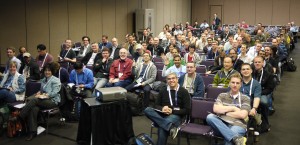When you’re speaking at a conference, try to get the room schedules long before the event day. Right now, the PASS Summit conference schedule is available, and each speaker’s room is listed.
Then, check out the building’s floorplan – in this case, the Washington State Convention Center’s floorplans page. Check out the seating capacity for your room.

You don’t have to think about filling the room or imagining the audience in their underwear, but knowing the size of the room can help you mentally prepare yourself for what you’ll be facing. I take different approaches in different room sizes.
In small rooms (for under 30 people), I look every single person in the eye and make sure they’re following along. When I’m losing somebody, I’ll prompt them for questions and change my presentation pace. I can make faces to illustrate my disbelief or happiness with a particular point, and I know everyone will see it.
In mid-size rooms (for 30-100 people), I’ll try to take the pulse of the audience by looking around. I’m less able to change the presentation pace based on facial expressions – and I’m less able to use my own facial expressions as a presentation tool. Repeating audience questions becomes critical here because people on one side of the room can’t hear questions from the other side.
In rooms designed for over a hundred people, I have to be more animated. People farther back can’t see my facial expressions at all, and I need to convey more things via audible cues. My visual cues have to consist of giant hand waving and pointing.
When I know the room size ahead of time, I can even adapt the presentation to work better. For example, in large rooms, I’ll use visual punch lines on the slides rather than trying to tell a story with my facial expressions. In addition, the bigger the room, the bigger the font – I can’t rely on projectors to convey small bullet points in a 500-person room.
Note that the room size – not the number of attendees – dictates your approach. If you’re in a giant room, it doesn’t matter if less than 30 people show up – you still have to use the big-room delivery style. And don’t judge your success based on the percentage of empty seats – that’s the success of the meeting planner, not you. It’s their job to pick the right room size for each presentation. Jeremiah and I are both in the monster 6E ballroom that holds over a thousand people. They’re betting that a whole lot of people want to hear me talk about AlwaysOn Availability Groups and him talk about A Developer’s Guide to Dangerous Queries!


2 Comments. Leave new
I will make sure to get in there ahead of time and sit in front row for all your presentations, thanks for the heads up!! I hate being lost in the crowd somewhere – have walked out of that room for the same exact reason before – nothing to do with speaker, just stand in a corner and trying to listen is very hard. Can’t focus well at all.
I always walk the room prior to my session, or sit into the room when someone else is presenting to check acoustics, font sizes and projector related issues.